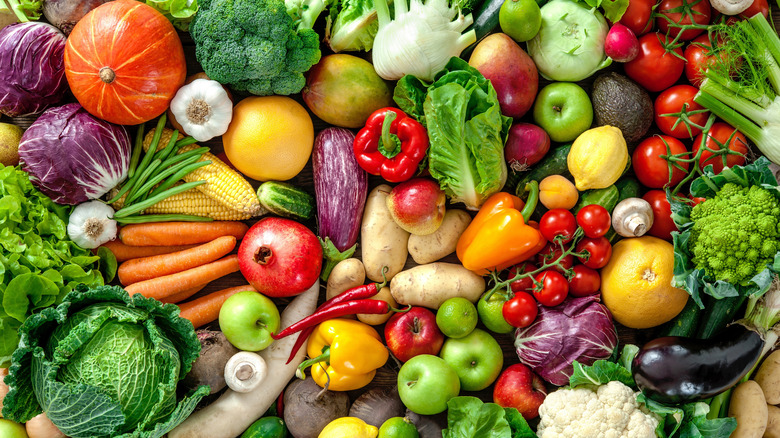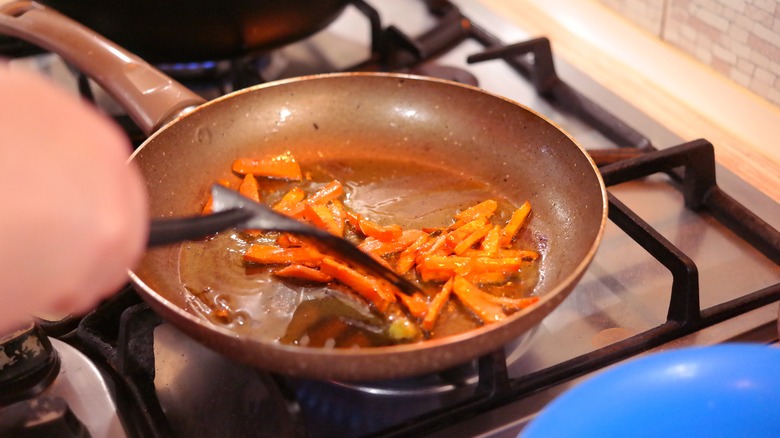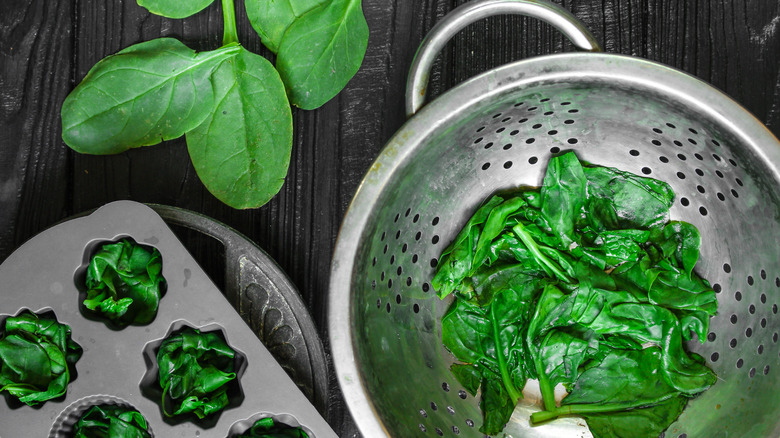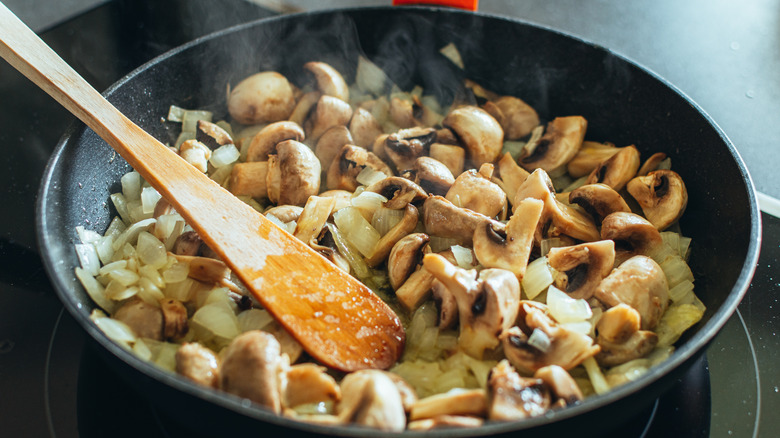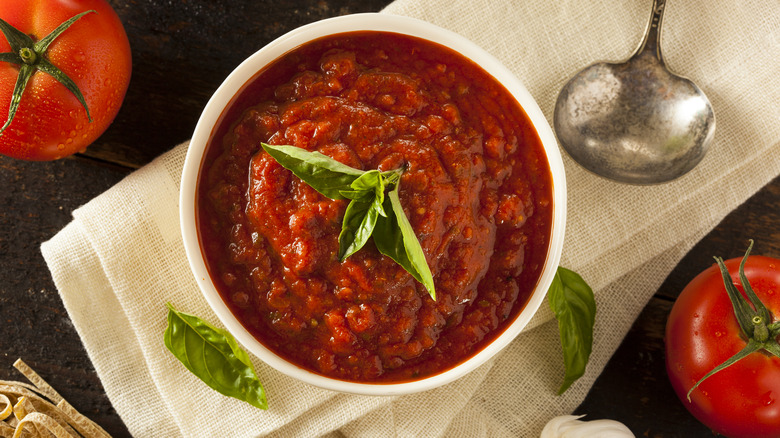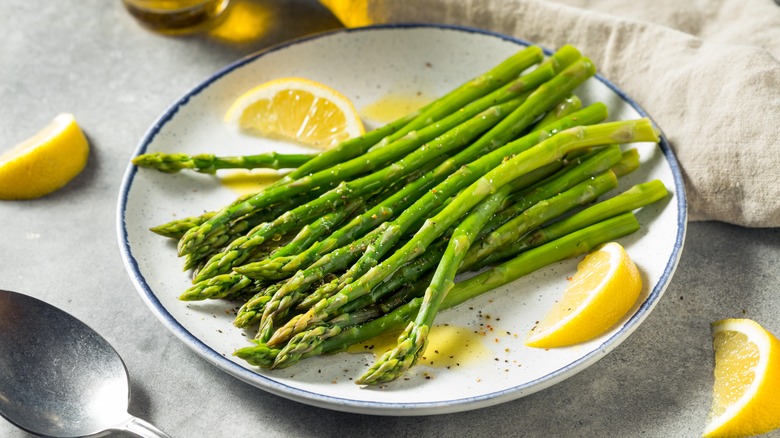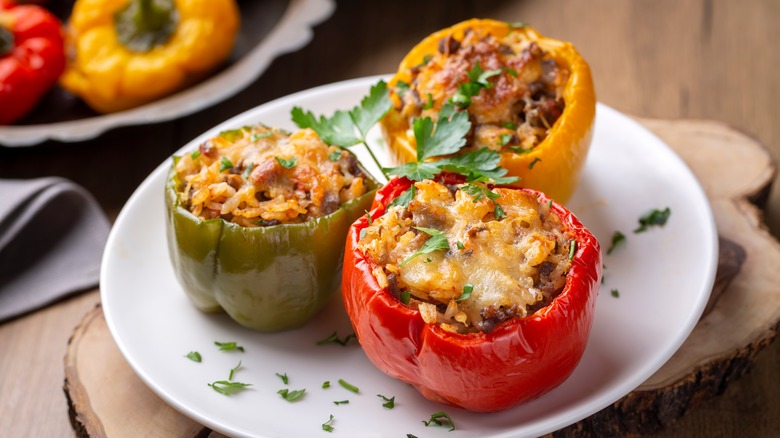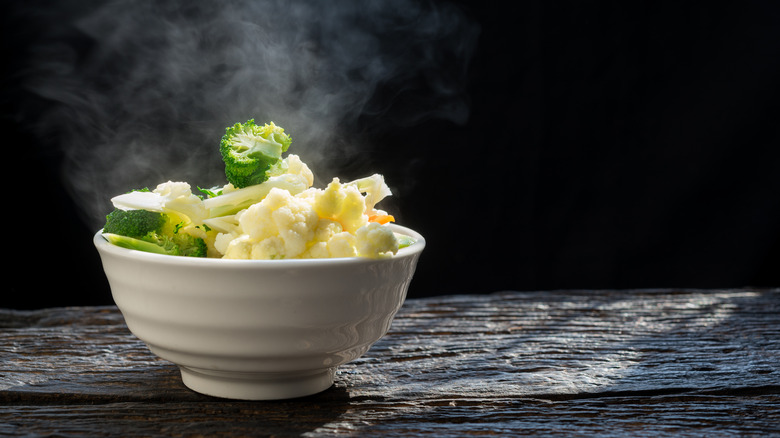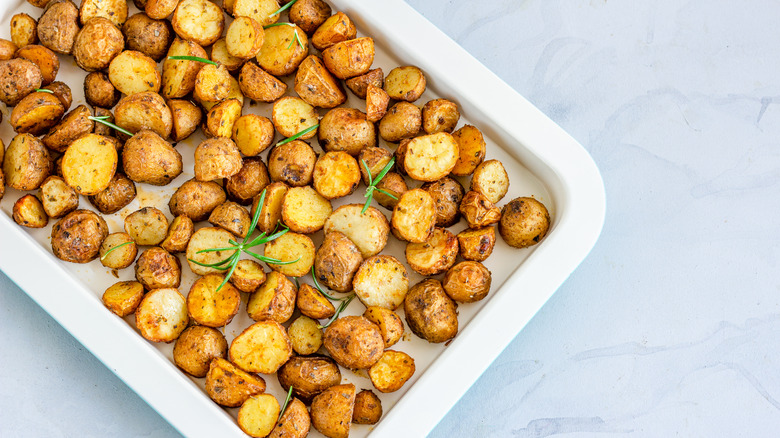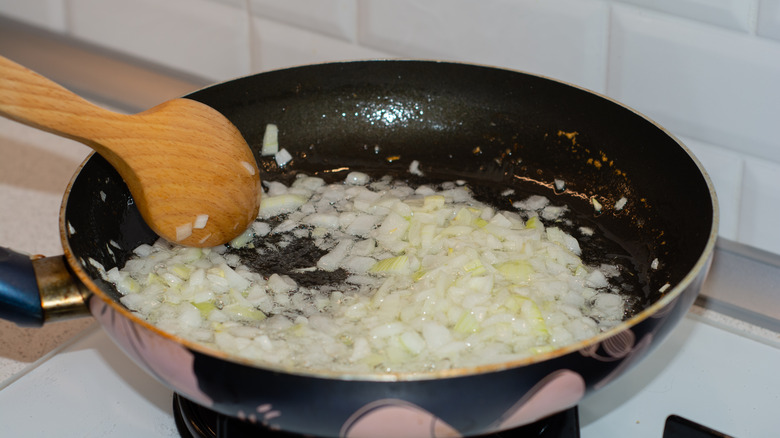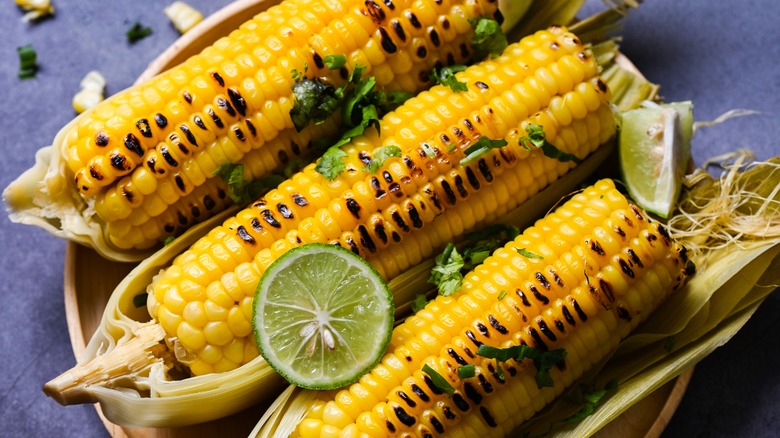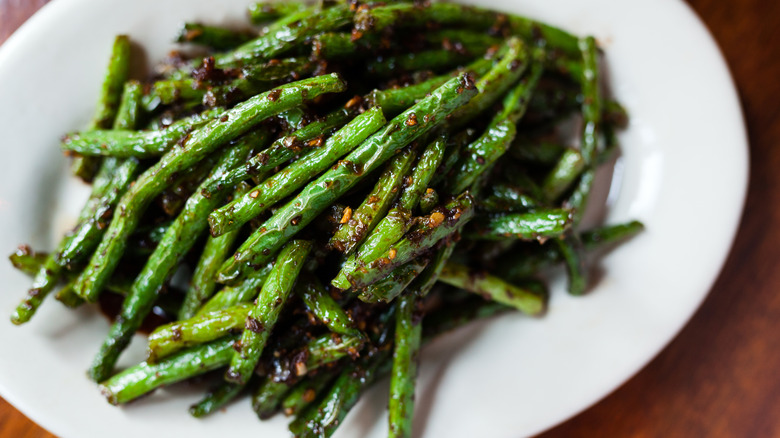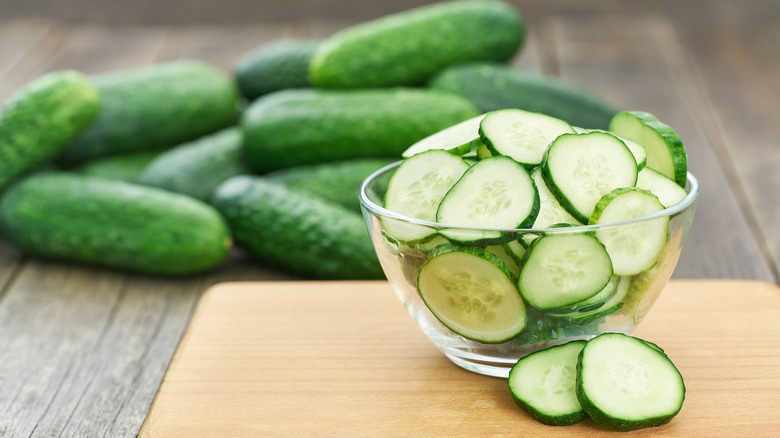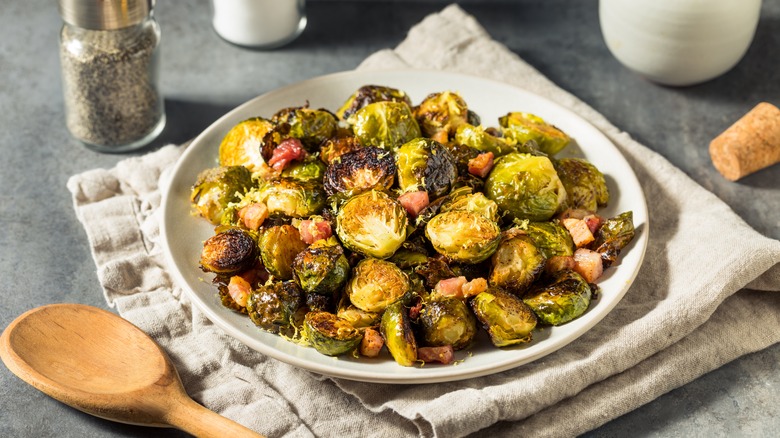13 Ways You're Cooking Your Vegetables Wrong
Ever since most of us were children, we have been hearing that we should be consuming more fruits and vegetables as part of a well-rounded, healthy diet. In fact, it is recommended that adults consume at least 2-3 cup-equivalents of vegetables per day, yet only one in 10 of us actually do. While the reasons for this may vary from availability to cost, often individuals simply do not know how to prepare particular vegetables in ways that are both nutritious and delicious.
While eating vegetables raw is often considered to be the best way to obtain their full nutritional value, this isn't always the case. For some nutrients, the process of cooking enables them to be more easily absorbed by the human body. There are some exceptions to this, however. Water-soluble vitamins (like C and B), fat-soluble vitamins (like A, D, E, and K), and minerals (like potassium, magnesium, sodium, and calcium) may be highly vulnerable to heat.
Nutrient loss to cooking can be mitigated somewhat depending upon how you cook your vegetables. The worst methods are typically boiling and frying, unless you plan on consuming the liquid you boil your vegetables in, like in a soup. Steaming, sautéing, and microwaving vegetables are generally better options, although this is not the case with all vegetables. To demystify this, we took a deeper look into how best to prepare some of our favorite vegetables.
Carrots
According to Statista, carrots are one of the most popular vegetables consumed in the U.S. Not only are they delicious — they're nutritional powerhouses. They are rich in fiber, vitamin K, and carotenoids (like beta-carotene), which are converted into vitamin A in the body. These antioxidant-rich carotenoids have been linked with the potential of reducing the risk of a number of different types of cancer, including prostate, colon, stomach, and breast, per Healthline.
The key to obtaining the maximum absorption of these powerful carotenoids is to cook your carrots, as opposed to consuming them raw. Per a research review published in the Journal of Food Science and Technology, cooking carrots enhances the body's ability to absorb beta-carotene by breaking down the cellular structure of the tough vegetable, rendering it easier to convert into vitamin A. Additionally, cooking carrots with their peels on may triple the presence of antioxidants in them (via the Journal of Food Science).
While you can cook carrots using virtually any method, our favorite is braising them in a small quantity of liquid with a splash of maple syrup and the addition of some earthy spices, like cumin and paprika. Just make sure not to overcook them. Carrots are best when just fork tender, unless you are planning on mashing them or adding them into a soup. Additionally, if you are going to leave the peels on them when you cook them, be sure to scrub them really well prior to cooking to eliminate any grit.
Spinach
Where green, leafy vegetables are concerned, spinach is king. For every 3 cups of spinach consumed, you are obtaining 300% of the recommended daily value (RDA) of vitamin K, 160% RDA of vitamin A, 40% RDA of vitamin C, and 45% RDA of folate. It is also incredibly high in iron, anti-inflammatory antioxidants, cardiovascular supporting nitrates, and lutein, which has been linked with the prevention of age-related macular degeneration (AMD), per Health. The key is to consume it daily, and to do so both raw and cooked.
While there may not be a bad way to prepare spinach, there are better and worse ways to eat it depending upon which nutrients you are seeking to extract. To preserve lutein content, add chopped spinach to a smoothie, or eat it in a salad. If you are seeking to minimize vitamin loss, steaming spinach is the best way to cook it. For maximum calcium and iron absorption, blanched spinach may be the winning strategy thanks to the presence of oxalic acid. This acid inhibits the absorption of these nutrients in raw spinach, but it tends to yield under high heat, its presence decreasing by up to 40%.
Mushrooms
The subject of cooking mushrooms is complicated. In this case, there are two factors to consider: One is nutritional value, and the other is texture. According to Time, research conducted at the Mushroom Technological Research Center of La Rioja in Spain sought to discover the best way to preserve the mushrooms' innate fiber, protein, vitamins, and minerals when cooked. Their results, which were published in the International Journal of Food Sciences, concluded that grilling or microwaving mushrooms was the best way to minimize nutrient loss, while boiling or frying were the worst. Please note: While some mushrooms can be consumed raw, many are toxic when eaten raw, so mushrooms should generally be eaten cooked in some capacity (via Consumer Reports).
For those objecting to the texture of cooked mushrooms, which can sometimes be spongy or squishy, microwaving them can result in an almost inedible product. Microwaving retains far too much of the moisture within the mushroom and results in a rubber ball-like texture. The solution? While you may lose some nutrients, we maintain that sautéing mushrooms in a pan with a combination of butter and olive oil until they are caramelized is the best way to obtain the ideal texture for them, which should be slightly firm and almost meaty. Just remember not to overcrowd the mushrooms in the pan. Season them with salt at the end of cooking and add a hint of freshly grated nutmeg to give them a pop of flavor.
Tomatoes
While they are technically a fruit, not a vegetable, there are certainly few greater pleasures in life than eating a perfectly ripe, fresh heirloom tomato that has been sun-kissed and naturally sweetened, straight from your garden. Not only are they delicious, but vine-ripened tomatoes confer far higher values of nutrients than their store-bought alternatives, particularly when it comes to the antioxidant lycopene.
Tomatoes are one of the few vegetables that contain high amounts of lycopene, which has a myriad of health benefits thanks to its unique capacity for isolating free radicals, which are unstable atoms that can contribute to aging, illness, and the degradation of cells within the body, per Medical News Today.
Lycopene is one nutrient that actually improves in nutritional value when cooked. Heating a tomato at 190.4 degrees Fahrenheit for just 30 minutes can increase the amount of lycopene our bodies can absorb by 35%. The primary reason for this is the way in which cooking a tomato causes the cellular structure of the fruit to be broken down, increasing the lycopene's availability for use. So while consuming a tomato soup or marinara may actually be the healthiest way to eat a tomato, puréeing, chopping, or otherwise processing a tomato (such as in a salsa or gazpacho) can also increase the availability of lycopene. As a bonus, lycopene is a fat-soluble nutrient, so adding some oil to your raw tomatoes can markedly improve its absorption capacity.
Asparagus
While asparagus is traditionally consumed cooked, it can be eaten raw as well. The biggest factor in consuming raw asparagus is access to nutrients and digestibility, as it is a particularly dense, fibrous vegetable. When shredded, sliced, or otherwise broken down, raw asparagus can be delightful in salads. That being said, cooking asparagus does have its nutritional benefits, particularly when it isn't overcooked. This is especially important where antioxidants are concerned. Overall antioxidant availability in green asparagus increases by 16% when cooked, while it may increase the antioxidant accessibility in white asparagus three-fold.
The best methods for cooking asparagus include sautéing, roasting, steaming, or microwaving. Boiling asparagus not only washes away many nutrients, particularly water-soluble vitamins like vitamin C, but it makes asparagus mushy and stringy. If you plan to turn asparagus into a soup, we suggest blanching it first, until just tender but still a bright green hue, and then puréeing it together with broth and seasonings for a delicious and nutritious soup.
Bell peppers
The bell pepper is another vegetable that represents a bit of a conundrum. While certain nutrients within the bell pepper may lose their efficacy due to cooking, peppers can be notoriously difficult to digest due to their tough skins, making cooking them necessary for some individuals to obtain any of the peppers' nutritional value. Bell peppers, particularly red ones, contain more vitamin C than most other vegetables, with one cup of chopped raw red pepper having 317% of the recommended daily value. Since vitamin C is a water-soluble vitamin, cooking peppers significantly reduces the availability of this nutrient, especially when they are boiled.
On the flip side, bell peppers are also rife with carotenoids, specifically beta-carotene, which is converted into immune-supporting vitamin A when consumed. Carotenoids are far more likely to be absorbed when peppers are cooked, thanks to the breakdown of the cellular structure of the pepper when heated. They are also fat-soluble, meaning if you sauté, roast, or stir-fry peppers in a bit of oil, you will amp up the bioavailability of these powerful carotenoids. It's no wonder that so many cultures have incorporated bell peppers into their culinary vocabularies in recipes like stuffed bell peppers.
Broccoli and cauliflower
Broccoli and cauliflower are cruciferous vegetables that are part of the Brassica genus of plants. This particular group of vegetables is known for being high in fiber, folate, and carotenoids; they're also distinctly rich in sulfuric chemicals known as glucosinolates. Aside from conferring a distinct aroma to these vegetables, glucosinolates are broken down into cancer-fighting compounds called indoles and isothiocyanates when the vegetable is chewed, according to the National Cancer Institute.
There is a hitch in the giddyup where these glucosinolates are concerned, and that is that they lose their cancer-fighting properties when cooked. However, many individuals cannot properly digest raw broccoli or cauliflower due to the amount of fiber in them. Cooking can break these gas-producing fibers down, making these vegetables digestible. It appears to be a catch-22, but it is not. According to research published in the Journal of Agricultural and Food Chemistry (via Consumer Reports), steaming these vegetables will not adversely affect the enzyme myrosinase, which is the specific cancer-fighting powerhouse in crucifers. Furthermore, cutting your broccoli or cauliflower and allowing it to sit for at least 40 minutes prior to steaming will also encourage the release of myrosinase. The key for maximum health benefit is to not overcook them.
Potatoes
There are more than 200 different varieties of potatoes, making the best and worst way of cooking them a bit of a loaded topic. Each type of potato has its own distinct nutritional and characterological profile. However, there are some basics that can be applied based on what type of potato you're cooking, namely starchy, waxy, or all-purpose.
At their most fundamental level, potatoes have two primary distinguishing factors, their starch content and their moisture level. Waxy potatoes — like French fingerling, Red Bliss, and baby potatoes — are known for their low starch and high moisture content. These potatoes are typically used for recipes where you need them to hold their shape, like roasting or a potato salad. Starchy potatoes, like Russets, are epitomized by their high starch and low moisture content, making them ideal for mashing or baking. All-purpose potatoes, like the Yukon Gold, have medium starch and moisture content, making them a good option for almost any recipe.
One of the primary factors in preserving the nutritional value of potatoes when cooking them is leaving the skins intact. The skins double the fiber of a potato and increase their potassium by a third. Just be sure to scrub the skins thoroughly before cooking the potato. And ultimately, the recipe you choose will influence the nutritional value of a potato, with recipes heavy on the cream and butter overshadowing any potential health benefit thanks to the added saturated fat.
Onions
Onions, or Allium cepa, are a core ingredient in cuisines across the globe. In the U.S., approximately 85% of all onions grown and consumed are yellow onions, which are known for their mild, sweet flavor, and juicy texture. While onions can be eaten raw or cooked, there are some considerations to be made in terms of how best to prepare them. Like with other vegetables, some key nutrients in onions do suffer from the process of cooking, chief among them being pyruvate, sulfur compounds, and quercetin. Pyruvate is a key element in preventing blood clots, sulfur compounds have purported anti-cancer properties, and quercetin has been linked to both heart health and lowering the risk of cancer, according to MedicineNet. The longer onions are cooked, the more of these nutrients they will lose.
With that in mind, raw onions are notoriously challenging to eat. They can aggravate acid reflux, cause eye irritation, promote the production of gas in the digestive system, and give you a severe case of bad breath. It is therefore recommended that onions be consumed lightly sautéed for maximum health benefit and minimum digestive discomfort. However, don't let that stop you from making a classic French onion soup. Sometimes you have to sacrifice a bit of nutrition for the sake of flavor, and there are few things more delicious on this planet than onions that have been slowly caramelizing for hours.
Corn
Like with other vegetables, corn loses most of its nutritional value when boiled, unless the liquid is consumed, like in a soup. However, grilling or microwaving fresh corn in its husks not only preserves many nutrients but makes for easier cleanup once the corn has been cooked. Just be sure not to overcook fresh corn. Its sweetness shines through best when it is just heated through.
Alternately, canned and frozen corn can be a healthy and convenient option for incorporating corn into your diet. Indeed, canned corn not only retains much of the fiber, protein, vitamin C, beta-carotene, minerals, and antioxidants in corn, but it is also a superb source of B vitamins. Because these are water-soluble vitamins, we recommend using canned corn in salads, salsas, or added at the very end of cooking to garnish pasta dishes. Minimizing cooking will retain all of those brain health-supporting B vitamins (via Livestrong). If you do opt to cook canned corn, sauté it lightly to add to a succotash or stir-fry.
Green beans
Green beans are one vegetable that should be consumed cooked in spite of minor nutrient loss, predominantly in the form of water-soluble vitamins like C and folate. Green beans are a legume, and like other legumes, they may be high in lectins. Lectins are considered an antinutrient, meaning they can potentially disrupt the body's digestive system causing nausea, diarrhea, and the degradation of your gut biome, according to Healthline. This may result in the body's inability to absorb potential nutrients, so even if it may be safe to consume raw green beans in small quantities, we advise against it.
Additionally, cooked green beans have higher levels of antioxidants and isoflavones, which purportedly isolate free radicals and prevent cancer. While Healthline suggests boiling, steaming, or microwaving green beans, for the sake of flavor, texture, and color, we recommend sautéing or roasting your green beans. The process of roasting green beans takes advantage of the starches within them, converting them to sugar and caramelizing them to create a delectable, nutty flavor. If you plan on using fresh green beans in a classic green bean casserole, we recommend blanching them briefly to cook them through prior to adding them to your recipe.
Cucumbers
Cucumbers are gourds that are actually berries, not vegetables. They are made up of 96% water and are loaded with nutrients, including antioxidants, potassium, and vitamin K. Most of these nutrients are found in their peels, so it is advised that you consume them with their peels on. Because they are low in carbohydrates, they are considered to be a great option for those needing to regulate their blood sugar levels, per WebMD.
While cucumbers are predominantly consumed raw in salads, slaws, or pickled, they can be cooked. One of our favorite ways of cooking them is to bake them in the oven. The key to doing so is to cut the cucumbers lengthwise and then in half. Then you can cut each quarter into smaller segments, salt them, and allow them to drain on paper towels. By doing so, you eliminate some of the moisture that can make them soggy. We doctor our baked cucumbers up with some smoked sea salt, freshly grated nutmeg, garlic powder, and a liberal garnish of freshly grated parmesan cheese. It's the perfect side dish on a hot summer night.
Brussels sprouts
Cooking Brussels sprouts is the best way to enjoy them both in terms of maximizing their nutritional value and increasing their digestibility. Like other cruciferous vegetables, Brussels sprouts can be notoriously challenging to eat raw due to the amount of gas-producing fiber in them. They may also contain glucosinolates, which can reduce the absorption of iodine, making them contraindicated for those with thyroid dysfunction, according to Healthline. The choice to eat them raw may be an individual one, based upon your tastes and digestive health. If you do opt to consume them raw, make sure they are cut finely and added to salads or slaws.
That being said, we think the most delicious way of consuming them is to coat them in a hint of oil, season with salt and pepper, and roast them in the oven. The key is to find the sweet spot for oiling your Brussels sprouts. If you don't add enough oil, you won't achieve the proper caramelization to convert the natural sugars of Brussels sprouts into a nutty, umami-filled delight. If you overdo the oil, you basically drown your Brussels sprouts, making them a soggy mess. The sweet spot is typically 2 tablespoons of oil to 1 pound of Brussels sprouts. Be sure to cut larger sprouts in half, and consider using a different fat, like bacon, to amp up the flavor. And tossing roasted sprouts in some balsamic vinegar and garnishing with freshly grated parmesan makes for a delightful side dish.
Static Media owns and operates Daily Meal and Mashed.
